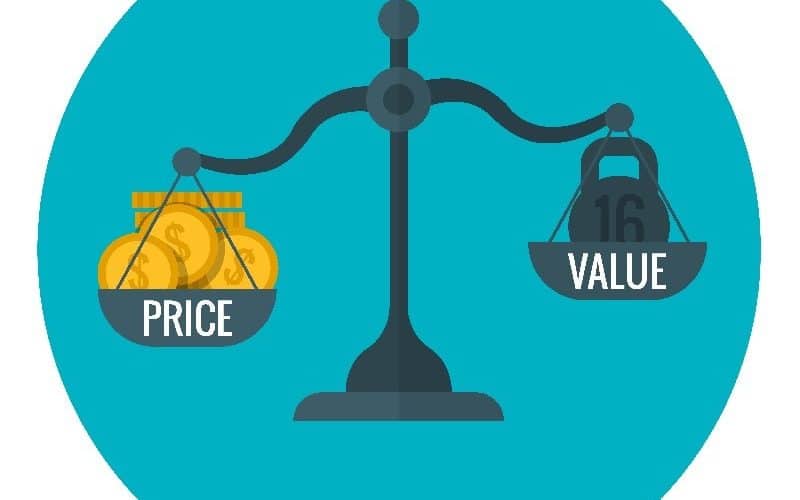Value-based pricing is one of the most difficult pricing methods to implement. It necessitates extensive research into your target demographic, the wider market, and competitor product offerings.
The analysis, on the other hand, is well worth the effort. When you implement a value-based pricing strategy, you not only have a flexible strategy that responds to market demand, but you also learn a lot more about your target audience and competitors. Read on to learn more about value-based pricing with examples
What is Value-Based Pricing?
Value-based pricing, also known as value-added pricing or perceived value pricing. According to Utpal Dholakia, a marketing professor at Rice University, value-based pricing is “the process of setting a price by which a business estimates and attempts to earn the differentiated worth of its product for a specific consumer segment as compared to its rival.”
Value-based pricing is a catch-all concept for any pricing approach that recognizes a product’s value in the eyes of the customer and industry. Companies may create a framework that leverages their brand, product characteristics, audience demographics, and market position by using a value-based pricing approach.
Cost-Based Pricing vs. Value-Based Pricing
Value-based pricing and cost-based pricing are two very different pricing strategies.
The most basic pricing approach is cost-based pricing. It is simple to put into action. All you have to do is think about the costs per commodity and then put your ideal margin on top of that.
There is no concern for how the product relates to those on the market or how the target audience perceives the product with cost-based pricing. If the prices are too high and the resulting market price does not meet customer expectations, you will be outpriced.
Value-based pricing is more complex. This approach employs demand economic concepts and takes into account both internal and external influences. You’ll develop a scalable pricing plan, promotes the brand image, and take into account all market factors after conducting detailed research into the target demographic, larger market, and product requirements.
The Benefits and Drawbacks of Value-Based Pricing
Value-based pricing strategies are difficult to implement, but they are the most recommended pricing strategy for a reason.
The Benefits of Value-Based Pricing
Takes into account both internal and external variables:
Value-based pricing considers a variety of variables to ensure that all applicable factors are considered when setting a price. It is more strategic than cost-based pricing in several ways because it allows you to distinguish yourself from the competition.
- Improved knowledge of the playing field:
Value-based pricing necessitates extensive analysis. This research will help you better understand your target audience, competitors, and industry.
- More information:
The research you conduct on the competition and the needs of your target audience will inspire product development ideas.
- Increased profits:
In a value-based pricing system, you “maximize” your price by asking for the maximum price possible based on perceived value. This maximizes profits; as a manufacturer, you catch as much “consumer surplus” — the gap between a consumer’s perceived value and the price of a good — as possible.
Read Also: Cost-plus Pricing Strategies: Formula and Examples
Disadvantages of value-based pricing
- Complexity:
Value-based pricing can be challenging to enforce because it is a dynamic method that necessitates extensive study and analysis.
- It takes time:
Setting up a value-based pricing plan takes time because there is so much study and analysis involved.
What is a Value-Based Pricing Strategy?
Now that you understand what a value-based pricing strategy is, it’s time to get started on developing one. Here are all of the steps you need to take to get started on your value-based pricing strategy.
#1. Conduct research on your intended audience.
How is a product’s worth determined? Using meticulous analysis. Unfortunately, there is no clear price-value equation that can be applied universally. Instead, you must focus on analysis, which is at the heart of every value-based pricing formula.
You may begin in a variety of ways, but in a competitive market, consumers decide on perceived value. As a result, we suggest starting with research on your target audience to gain a thorough understanding of how the product impacts their lives.
This study would be a blend of demographic information about your target audience and qualitative information gleaned from interviews. Sure, you want to know your target audience’s income level, but it’s more important to know the issue you’re solving with a product and how much they’re willing to pay to solve that problem. You might already have a lot of ideas from product development research in your company, so reach out to the product team and ask for them.
However, if you are in charge of selling these items, don’t be afraid to contact your current customers and ask them additional questions. You should build good relationships with your current customer base to learn how they perceive your product, what features they are lacking, and to gather other feedback.
#2. Investigate your rivals
Many businesses assume that value-based pricing is solely concerned with the worth of their product. However, the fact is that the value of your commodity is only relative to the competition, and you need competitor pricing information to develop a value-based pricing strategy.
If your product is €900 more expensive than your nearest rival, you’d better have a good reason for it. Consumers would choose the cheaper alternative if there is an insufficient value generated in the commodity (and its marketing).
As a result, the second phase in value-based pricing is competitive analysis. At this point, your aim is to examine the market’s next best alternatives and understand what distinguishes your product. At this point, you can look at the product’s actual features.
Consider if your commodity:
- Lasts longer than the next best choice
- It appears to be made of high-quality materials.
- Provides more features (like longer battery life, for example)
- Is more expensive to produce than the competitor Is priced higher than the industry average
Again, the R&D team might have a lot of these ideas, so go ahead and study the competitor products. You may also use price comparison tools to gain additional industry insights.
Price Elasticity and Value-Based Pricing Techniques
Data on price elasticity is extremely useful during the research process of developing a value-based pricing strategy. “Omnia will quantify a product’s price elasticity and reveal customers’ ability to pay for a product,” says Omnia Consultant Jelmer Reijerink. “If you have access to this data, you will be able to gain even more insights into how the consumer reacts to your product.”
#3. Determine the worth of your distinction.
You’ve done all of your testings. It’s now time to assign a monetary value to the various features you discovered in phase two.
To do so, consider how much the main features of your product are worth. What is the value of extra screen space? What about a battery that lasts longer? How about higher-quality materials? Assign a monetary value that represents the value of that function.
You may not need to allocate a value to any single product feature; instead, you just need to measure the value of the features that distinguish your product. This is a brilliantly easy way to stop doing a lot of work that isn’t appropriate.
#4. Create marketing and pricing strategies that meet the needs of your target market.
You may build a value-based pricing plan that is tailored for your product after knowing the needs of your audience, your competitor’s alternative goods, and where your product stands.
What is a Value-Based Pricing Strategy in Marketing?
Begin with marketing. When developing a value-based pricing strategy, marketers must first determine whether to add value or rely on functionality. This is the point at which you must be strategic.
There are two simple value-based pricing strategies.
#1. Good value pricing strategy
A good value pricing approach focuses on functionality rather than price. The aim is to persuade customers that they are having a good product at a reasonable price.
Marketers do not need to concentrate on generating a lot of added value when developing marketing strategies for these types of goods. Build a campaign that clearly identifies the consumer’s dilemma and how your product addresses it. Emphasize how the product’s features address these issues.
Good value pricing is ideal for more “pure” goods with little extra fluff. These items are also less costly and may be vulnerable to the ROPO effect.
#2. Value added pricing strategies
Value-added pricing and marketing techniques, on the other hand, are concerned with increasing a product’s perceived value. This is often used to justify a higher price.
A value-added approach, as opposed to a good value pricing strategy, focuses on what makes a product different and special. You should consider functionality, but the emphasis of your campaign should be on the benefits.
So, if you’re a marketer working on a campaign for a high-end or luxury product, it’s time to dust off your textbooks and revisit Maslow’s Hierarchy of Needs. At the top of the pyramid, add value by focusing on how the product makes others feel. Will the product improve their social standing? Will it assist the customer in reaching their full potential? Create meaning around these concepts.
A Value-Based Pricing and Marketing Campaign Example
De Beers Diamonds’ popular tagline “A diamond is forever” is an example of a value-based value-added pricing technique.
Frances Gerety’s 1947 line forever changed the diamond industry and helped explain the exorbitant cost of engagement rings. De Beers framed the product as an important demonstration of love in the campaign, which changed the way we think about diamond rings.
Diamond engagement and wedding rings are still an important part of many people’s marriages today. Buying or receiving a ring is a sign of achievement, as well as a sign of social belonging and affection.
Can value-based pricing be used in B2B and B2C industries?
Value-based pricing can be used in both B2B and B2C industries, as long as the customer perceives value in the product or service being offered.
How does value-based pricing impact a business’s profit margins?
Value-based pricing can positively impact a business’s profit margins by allowing the business to charge a premium for high-value products or services.
How does value-based pricing impact a business’s competitiveness?
Value-based pricing can increase a business’s competitiveness by allowing the business to differentiate itself from competitors and position itself as a high-value provider.
Can value-based pricing be used in conjunction with other pricing strategies?
Yes, value-based pricing can be used in conjunction with other pricing strategies, such as volume discounts, promotional pricing, and more.
How does value-based pricing impact the customer’s buying decision?
Value-based pricing can positively impact the customer’s buying decision by ensuring that the customer feels that they are paying a fair price for the value they receive.
How does value-based pricing impact the customer’s perceived value of a product or service?
Value-based pricing can increase the customer’s perceived value of a product or service by ensuring that the customer feels that they are paying a fair price for the value they receive.
Conclusion
The secret to pricing success is matching the commodity to the consumer’s perception of value. And, while cost-based pricing is a clear mechanism for pricing policy, it does not take the customer into account at all.
That is why value-based pricing is so successful — it considers every aspect of the pricing and marketing mix. A great value-based pricing strategy, once developed, strengthens your brand promises, keeps you agile in the market, and gives you more visibility into what consumers want from your product.
Value Based Pricing FAQs
Why value-based pricing is best?
Value-based pricing ensures that your customers feel happy paying your price for the value they’re getting. … You’ll also strengthen your brand name, build better customer relationships, and ultimately improve your bottom line. Value-based pricing is the only true win-win scenario for you and your customer
Which is better cost-based or value-based pricing?
Prices. When a company uses cost-based pricing, it prices between the price floor and the price ceiling. … If it uses value-based prices, the company sets its pricing in a range determined by what customers are willing to pay. Generally, the value-based price is higher.
What is the reverse of value-based pricing?
Reverse pricing is a form of value-based pricing, where the price is determined by customer perceptions rather than supplier guesses. Unlike most pricing models, reverse pricing allows the buyer to have much more leverage than usual. Reverse pricing often works in only specific markets or market conditions.
What is value pricing with example?
For example, at a concert, bottled water may be on sale for $6. However, you can buy the same bottle from a vending machine outside of the concert area for $1 only. The difference in pricing is reflected in the scarcity of water at the concert, and the need for concertgoers to drink water
- Pricing Analysis Techniques: Detailed Guide to Price Analysis
- Competitive Pricing: How to do Competitive Pricing Analysis
- Pricing Strategies: Top 7 Examples of Pricing Strategies
- Competitor Analysis: All you need (+ How to Start Guide)
- Premium Pricing Strategy: Overview & Detailed Example
- 7 business growth hacks for 2021 [with guide]







